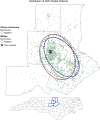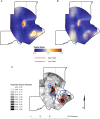The Excess Burden of Cytomegalovirus in African American Communities: A Geospatial Analysis
- PMID: 26716106
- PMCID: PMC4691661
- DOI: 10.1093/ofid/ofv180
The Excess Burden of Cytomegalovirus in African American Communities: A Geospatial Analysis
Abstract
Background. Cytomegalovirus (CMV) is a common cause of birth defects and hearing loss in infants and opportunistic infections in the immunocompromised. Previous studies have found higher CMV seroprevalence rates among minorities and among persons with lower socioeconomic status. No studies have investigated the geographic distribution of CMV and its relationship to age, race, and poverty in the community. Methods. We identified patients from 6 North Carolina counties who were tested in the Duke University Health System for CMV immunoglobulin G. We performed spatial statistical analyses to analyze the distributions of seropositive and seronegative individuals. Results. Of 1884 subjects, 90% were either white or African American. Cytomegalovirus seropositivity was significantly more common among African Americans (73% vs 42%; odds ratio, 3.31; 95% confidence interval, 2.7-4.1), and this disparity persisted across the life span. We identified clusters of high and low CMV odds, both of which were largely explained by race. Clusters of high CMV odds were found in communities with high proportions of African Americans. Conclusions. Cytomegalovirus seropositivity is geographically clustered, and its distribution is strongly determined by a community's racial composition. African American communities have high prevalence rates of CMV infection, and there may be a disparate burden of CMV-associated morbidity in these communities.
Keywords: African American; cytomegalovirus; disparity; epidemiology; geographic information system.
Figures




Similar articles
-
Neighborhood Disadvantage is Associated with High Cytomegalovirus Seroprevalence in Pregnancy.J Racial Ethn Health Disparities. 2018 Aug;5(4):782-786. doi: 10.1007/s40615-017-0423-4. Epub 2017 Aug 24. J Racial Ethn Health Disparities. 2018. PMID: 28840519 Free PMC article.
-
Geographic Disparities in Cytomegalovirus Infection During Pregnancy.J Pediatric Infect Dis Soc. 2017 Sep 1;6(3):e55-e61. doi: 10.1093/jpids/piw088. J Pediatric Infect Dis Soc. 2017. PMID: 28201739 Free PMC article.
-
Seroprevalence of cytomegalovirus infection in the United States, 1988-1994.Clin Infect Dis. 2006 Nov 1;43(9):1143-51. doi: 10.1086/508173. Epub 2006 Oct 2. Clin Infect Dis. 2006. PMID: 17029132
-
Review and meta-analysis of the epidemiology of congenital cytomegalovirus (CMV) infection.Rev Med Virol. 2007 Jul-Aug;17(4):253-76. doi: 10.1002/rmv.535. Rev Med Virol. 2007. PMID: 17579921 Review.
-
Review of cytomegalovirus seroprevalence and demographic characteristics associated with infection.Rev Med Virol. 2010 Jul;20(4):202-13. doi: 10.1002/rmv.655. Rev Med Virol. 2010. PMID: 20564615 Review.
Cited by
-
Newborn Screening for Congenital Cytomegalovirus (cCMV) Infection: Universal, Targeted, Expanded-Targeted, or None-of-the-Above?Neonatol Today. 2024 Aug;19(8):3-12. Neonatol Today. 2024. PMID: 39445079 Free PMC article.
-
Neighborhood Disadvantage is Associated with High Cytomegalovirus Seroprevalence in Pregnancy.J Racial Ethn Health Disparities. 2018 Aug;5(4):782-786. doi: 10.1007/s40615-017-0423-4. Epub 2017 Aug 24. J Racial Ethn Health Disparities. 2018. PMID: 28840519 Free PMC article.
-
Geographic and Racial Disparities in Infant Hearing Loss.Otolaryngol Head Neck Surg. 2018 Dec;159(6):1051-1057. doi: 10.1177/0194599818803305. Epub 2018 Oct 9. Otolaryngol Head Neck Surg. 2018. PMID: 30296906 Free PMC article.
-
Human cytomegalovirus in breast milk is associated with milk composition and the infant gut microbiome and growth.Nat Commun. 2024 Jul 23;15(1):6216. doi: 10.1038/s41467-024-50282-4. Nat Commun. 2024. PMID: 39043677 Free PMC article.
-
Seroprevalence of Cytomegalovirus Infection Among HIV-Infected and HIV-Uninfected Pregnant Women Attending Antenatal Clinic in Harare, Zimbabwe.Viral Immunol. 2019 Sep;32(7):289-295. doi: 10.1089/vim.2019.0024. Epub 2019 Jul 26. Viral Immunol. 2019. PMID: 31347990 Free PMC article.
References
-
- Calhoun P. Unconditional Exact Test. Available at: https://cran.r-project.org/web/packages/Exact/Exact.pdf. Accessed 1 September 2015.
-
- Boschloo R. Raised conditional level of significance for the 2 × 2-table when testing the equality of two probabiities. Statistica Neerlandica 1970; 24:1–35.
-
- Vieira V, Bartell S, Bliss R. Mapping Smoothed Effect Estimates from Individual-Level Data. Available at: https://cran.r-project.org/web/packages/MapGAM/MapGAM.pdf. Accessed 1 September 2015.
-
- Fowler KB, Pass RF. Sexually transmitted diseases in mothers of neonates with congenital cytomegalovirus infection. J Infect Dis 1991; 164:259–64. - PubMed
-
- Fowler KB, Pass RF. Risk factors for congenital cytomegalovirus infection in the offspring of young women: exposure to young children and recent onset of sexual activity. Pediatrics 2006; 118:e286–92. - PubMed
Grants and funding
LinkOut - more resources
Full Text Sources
Other Literature Sources

